Troitsk, Chelyabinsk Oblast
| Troitsk (English) Троицк (Russian) | |
|---|---|
| - Town - | |
 View of Troitsk | |
 Troitsk | |
|
| |
.png) |
|
|
| |
| Administrative status (as of September 2011) | |
| Country | Russia |
| Federal subject | Chelyabinsk Oblast |
| Administratively subordinated to | Town of Troitsk[1] |
| Administrative center of | Troitsky District,[1] Town of Troitsk[1] |
| Municipal status (as of September 2011) | |
| Urban okrug | Troitsky Urban Okrug[1] |
| Administrative center of | Troitsky Urban Okrug,[1] Troitsky Municipal District[1] |
| Mayor[citation needed] | Viktor Shchekotov[citation needed] |
| Statistics | |
| Population (2010 Census) | 78,372 inhabitants[2] |
| - Rank in 2010 | 209th |
| Time zone | YEKT (UTC+06:00)[3] |
| Founded | 1743[citation needed] |
| Postal code(s)[4] | 457100 |
| Dialing code(s) | +7 35163[citation needed] |
|
| |
Troitsk (Russian: Тро́ицк) is a town in Chelyabinsk Oblast, Russia, located 175 kilometers (109 mi) east of the southern Ural Mountains and approximately 110 kilometers (68 mi) south of Chelyabinsk on the border with Kazakhstan. It stands on the east-flowing Uy River, a branch of the Tobol River. Population: 78,372 (2010 Census);[2] 83,862 (2002 Census);[5] 90,077 (1989 Census).[6]
Geography and climate
The Uy and Uvelka Rivers merge within the town boundaries and form a water body which serves as a reservoir for the Troitsk power station.
The landscape around the town is flat, although river valleys are hilly. The town is situated on the border of a forest-steppe zone. The climate is continental. The average temperature in January is −14 °C (7 °F), and +20 °C (68 °F) in July.
History

It was founded in 1743 by Ivan Neplyuyev as a head fortress of the Orenburg Line of forts during the Bashkir War of 1735-1740 and to protect the southern borders of Russia. Troitsk played major role in the rebellion of Pugachev, who besieged and captured the town in 1774.

Gradually from military settlement Troitsk has turned to a trading town with well-developed processing industry.
Administrative and municipal status
Within the framework of administrative divisions, Troitsk serves as the administrative center of Troitsky District, even though it is not a part of it.[1] As an administrative division, it is incorporated separately as the Town of Troitsk—an administrative unit with the status equal to that of the districts.[1] As a municipal division, the Town of Troitsk is incorporated as Troitsky Urban Okrug.[1]
Economy
Troitsk serves as a railway junction and a supply and trading center for the southern Ural Mountains mining district. The Russia-Kazakhstan border is immediately south of Troitsk (and is included in photograph). Several large, cultivated field patterns (elongated, rectangular shapes) are visible through the snow-covered landscape. Because the fields are large, it can be inferred that they are probably planted with spring wheat. Numerous circular, frozen lakes are scattered throughout the countryside around Troitsk.
The basis of industrial potential of a town is made by the most powerful in the Southern Urals Troitsk power station . Capacity of its power units makes 2500 Megawatt. At the station two new power units by capacity of 660 Megawatt everyone are being built now.
Stably the electromechanical plant (puts out теплообменные devices for powerful electric machines), factory rockwool plates of Danish firm "Rockwool", meat-packing industrial complex, industrial complex of manufacturing enterprises (puts out ferro-concrete products and a parquet), the light industry enterprises (garment factory and shop on release of bags of different function), the railway junction enterprises, the motor transportation enterprise on 01.01.2011. Troitsk 3012 subjects of small business are registered. The Population occupied in small-scale business makes 6,1 thousand persons. Troitsk is a large railway junction. Through Troitsk it trains pass to of Republic Kazakhstan and further to the states of Central Asia.
Other trunk-railway, passing through Troitsk, connects the Ural Mountains with the southern regions of Russia.
In vicinities of Troitsk there are deposits of clay for manufacture of a ceramic brick, sand, quartzite, a granite, rubble, used by the town's construction industry.
Facilities
There are four higher educational institutions in Troitsk. Most significant of them is the Ural state academy of veterinary medicine. About 5,000 students are trained there.
Other higher educational institutions are branches.
Culture
Various festivals, competitions, and concerts take place during the year.
Tourism
Troitsk is one of a few places of the Ural region where the historical environment is well preserved. There are 948 monuments of history and culture. Four of them are monuments of architecture of federal value. There are building of the central [hotel, a trading passage of merchants of brothers Yaushevs, the Saint-Troitsk temple, and trading numbers.
References
Notes
- ↑ 1.0 1.1 1.2 1.3 1.4 1.5 1.6 1.7 1.8 Resolution #161
- ↑ 2.0 2.1 "Всероссийская перепись населения 2010 года. Том 1" [2010 All-Russian Population Census, vol. 1]. Всероссийская перепись населения 2010 года (2010 All-Russia Population Census) (in Russian). Federal State Statistics Service. 2011. Retrieved June 29, 2012.
- ↑ Правительство Российской Федерации. Постановление №725 от 31 августа 2011 г. «О составе территорий, образующих каждую часовую зону, и порядке исчисления времени в часовых зонах, а также о признании утратившими силу отдельных Постановлений Правительства Российской Федерации». Вступил в силу по истечении 7 дней после дня официального опубликования. Опубликован: "Российская Газета", №197, 6 сентября 2011 г. (Government of the Russian Federation. Resolution #725 of August 31, 2011 On the Composition of the Territories Included into Each Time Zone and on the Procedures of Timekeeping in the Time Zones, as Well as on Abrogation of Several Resolutions of the Government of the Russian Federation. Effective as of after 7 days following the day of the official publication.).
- ↑ Почта России. Информационно-вычислительный центр ОАСУ РПО. Поиск объектов почтовой связи (Russian)
- ↑ "Численность населения России, субъектов Российской Федерации в составе федеральных округов, районов, городских поселений, сельских населённых пунктов – районных центров и сельских населённых пунктов с населением 3 тысячи и более человек" [Population of Russia, its federal districts, federal subjects, districts, urban localities, rural localities—administrative centers, and rural localities with population of over 3,000]. Всероссийская перепись населения 2002 года (All-Russia Population Census of 2002) (in Russian). Federal State Statistics Service. May 21, 2004. Retrieved February 9, 2012.
- ↑ Demoscope Weekly (1989). "Всесоюзная перепись населения 1989 г. Численность наличного населения союзных и автономных республик, автономных областей и округов, краёв, областей, районов, городских поселений и сёл-райцентров." [All Union Population Census of 1989. Present population of union and autonomous republics, autonomous oblasts and okrugs, krais, oblasts, districts, urban settlements, and villages serving as district administrative centers]. Всесоюзная перепись населения 1989 года (All-Union Population Census of 1989) (in Russian). Institute of Demographics of the State University—Higher School of Economics. Retrieved February 9, 2012.
Sources
- Законодательное Собрание Челябинской области. Постановление №161 от 25 мая 2006 г. «Об утверждении перечня муниципальных образований (административно-территориальных единиц) Челябинской области и населённых пунктов, входящих в их состав», в ред. Постановления №1577 от 29 августа 2013 г. «О внесении изменения в перечень муниципальных образований (административно-территориальных единиц) Челябинской области и населённых пунктов, входящих в их состав». Вступил в силу со дня официального опубликования. Опубликован: "Южноуральская панорама", №111-112, 14 июня 2006 г. (Legislative Assembly of Chelyabinsk Oblast. Resolution #161 of November 25, 2006 On Adoption of the Registry of the Municipal Formations (Administrative-Territorial Units) of Chelyabinsk Oblast and of the Inhabited Localities They Comprise, as amended by the Resolution #1577 of August 29, 2013 On Amending the Registry of the Municipal Formations (Administrative-Territorial Units) of Chelyabinsk Oblast and of the Inhabited Localities They Comprise. Effective as of the official publication date.).
External links
 Chisholm, Hugh, ed. (1911). "Troitsk". Encyclopædia Britannica 27 (11th ed.). Cambridge University Press. p. 300
Chisholm, Hugh, ed. (1911). "Troitsk". Encyclopædia Britannica 27 (11th ed.). Cambridge University Press. p. 300- The official website of the town administration (Russian)
- The Information site about a city, All city history, the directory (Russian)
| |||||||||||||||||